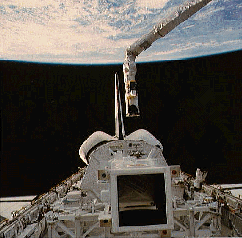|
|
Spartan 1

NASA's Spartan program was based on the idea of a simple, low-cost platform
deployed from a space shuttle in orbit for a 2-3 day flight, then recovered
and returned to Earth. The platform allows the experiments to get out of
the messy shuttle environment and frees it of any shuttle pointing
constraints.
Spartan-1 was deployed from the Space Shuttle Discovery (STS-51G) on
20 June 1985 and retrieved 45.5 hours later.
The X-ray detectors aboard the Spartan platform were sensitive to the
energy range 1-12 keV. The instrument scanned its target with narrowly
collimated (5 arcmin x 3 degrees) gas scintillation proportional counters.
There were 2 identical sets of counters, each having ~ 660 cm2 effective
area. Counts were accumulated for 0.812 s into 128 energy channels. The
energy resolution was 16% at 6 keV.
During its 2 days of flight, Spartan-1 observed the Perseus cluster of
galaxies and our galactic center region.
[Gallery] (http://heasarc.gsfc.nasa.gov/docs/heasarc/missions/images/spartan1_images.html)
[Publications] (http://heasarc.gsfc.nasa.gov/docs/heasarc/missions/biblio/spartan1_biblio.html)
|
